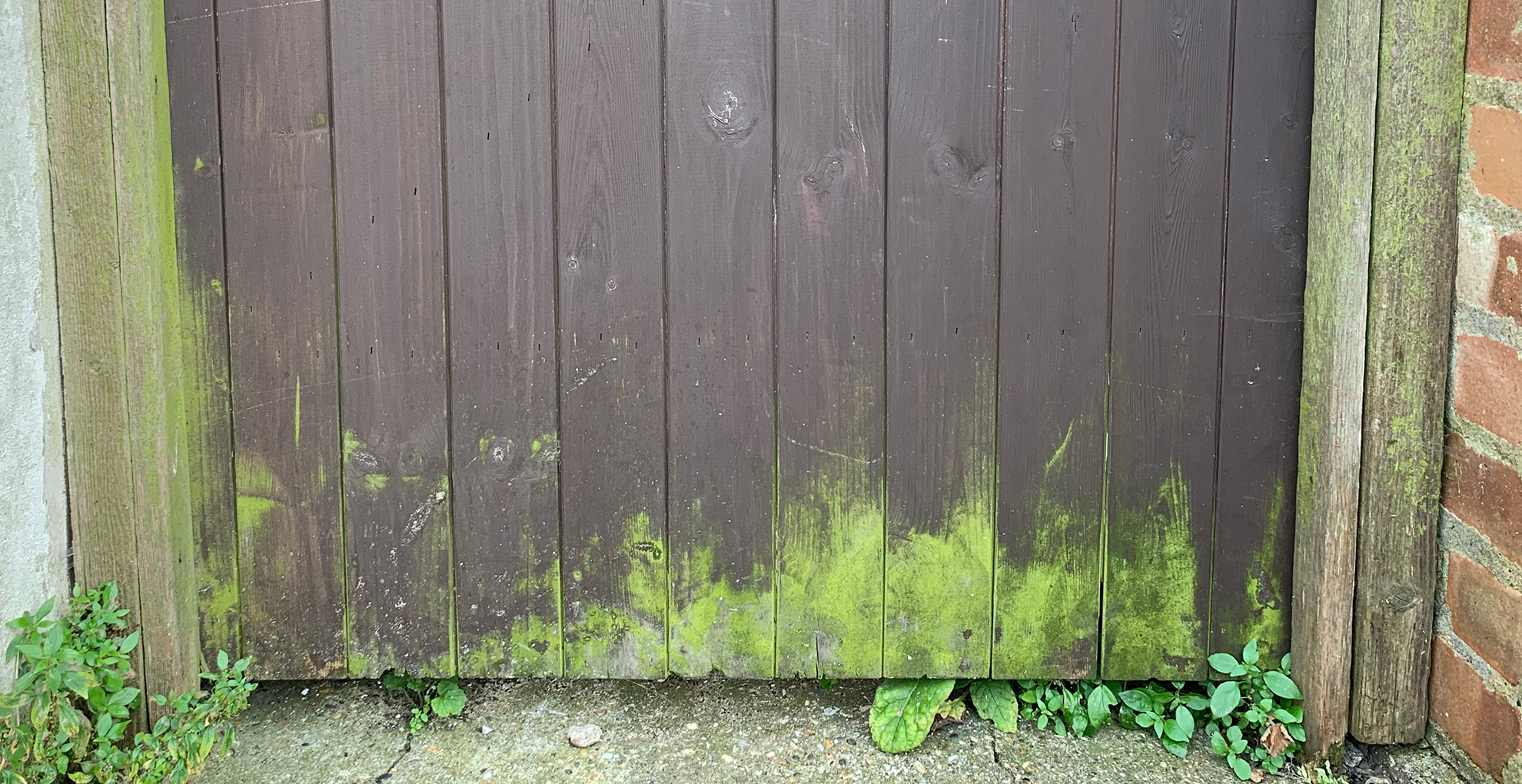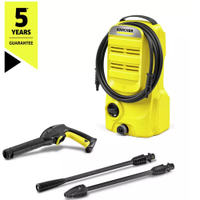How to remove algae on fence panels, sheds and furniture: easy ways to banish green growth
Remove all traces of green algae on wooden surfaces with the help of these expert tips and tricks


You may have noticed a build-up of green algae on wooden garden surfaces this summer, mainly due to the warm and wet conditions in which algae spores thrive. Luckily mastering how to remove algae on fence panels, sheds or wooden garden furniture is easier than you might think.
While having an outdoor space filled with greenery is the aim, bright green algae is not the desired look.
Despite popular garden trends that encourage a more holistic approach to gardening, such as the rewilding trend, algae growth is still not always welcome particularly when growing on wooden surfaces because it can cause damage such as wood decay and discolouration.
Covering everything from fences, garden gates and sheds to your best outdoor furniture and decking, knowing how to remove algae, like getting rid of ivy, is a good gardening tip to know.
How to remove algae on wooden garden surfaces
Removing algae from wooden surfaces such as fences, sheds and garden furniture is essential for prolonging the lifespan of these structures. Not to mention it's preferable to remove the bright green photosynthetic organisms to keep your wooden garden surfaces looking their best.
"Fence panels that are prone to algae can be cleaned in a few different ways depending on how big the fence is and what you have available," says Morris Hankinson, director of Hopes Grove Nurseries.
Similar to cleaning wooden garden furniture or cleaning wooden decking: "With a little elbow grease, fence panels can be cleared of algae and look brand new again."
Sign up to our free daily email for the latest royal and entertainment news, interesting opinion, expert advice on styling and beauty trends, and no-nonsense guides to the health and wellness questions you want answered.

1. Pressure wash
While there are some things you should not pressure wash, our experts say this is ok as long as you take a gentle approach.
"Using a pressure washer is one way to blast off algae," suggests Morris. "The pressure of the water will soon lift algae away and you will probably need to clean up afterwards as things can get a bit messy but it is probably the quickest and easiest way."
Don't have a pressure washer? "Pressure washers aren’t too expensive or you can hire one. They do use a lot of water though, so keep that in mind when deciding how to get rid of the algae."
Karcher K 2 Classic Pressure Washer: £90 at Argos
This is the entry-level Karcher model. The 1400W pressure washer features a 'Quick Connect' trigger gun, 3m high-pressure hose, single spray lance, dirt blaster and water filter.

Morris Hankinson is the founder and managing director of Hopes Grove Nurseries Ltd, the UK’s only specialist grower-retailer of hedging plants. He established the thriving business in 1992, shortly after graduating with a Commercial Horticulture Degree from Writtle College, Essex.
2. Mix a homemade cleaning solution
Algae requires more than a little soap and water to remove, but luckily a homemade cleaning solution is sufficient. “Commercial algaecide or biocide can be sprayed onto fences, walls and furniture and works well, but homemade recipes work just as well," explains gardening expert Mark Lane.
He goes on to suggest: “Mix either 1 part bleach, 1 part white vinegar, or 1 part baking powder to 4-6 parts warm water. Apply with a cloth, paintbrush, stiff brush or garden sprayer and leave for 20 minutes. Rinse off with clean, warm water."
"Please note, though, that this only works in areas where there are no plants or grass, as the bleach and vinegar will kill them."
If the algae is particularly heavy in coverage we recommend using a clean, stiff brush to help lift it off.
Top Tip: “Do a test application somewhere you can't see the test patch, whether using a bought or homemade solution, to check for bleaching of colour, staining or streaking," Mark suggests. "If all is OK, then apply liberally.
"For protection, I always recommend wearing a face mask and rubber gloves when applying any kind of solution.”

Not only is Mark a presenter on BBC's Gardeners World he is also an accredited gardening expert at stairlift and homelift company Stannah. Mark also runs his own gardening business when not providing useful tips and tricks for blossoming green thumbs.
What causes algae on a fence?
"Algae grows on wet surfaces and fences are the perfect place," Morris explains. "Wood that stays damp for long periods, such as if it is in shade, will inevitably get some algae growth. If you remove all algae, sand the fence and stain or paint it, this can help to ensure algae doesn’t take over again."
“Damp conditions cause algae, so it's always best to see why the area is getting damp," adds Laura Juniper, a wooden garden structure expert at Garden Buildings Direct.
"Perhaps there's a leaky water butt or downpipe that needs fixing, and excess watering of plants close to fences and walls could also be the culprit. Consider using a more directional hose attachment that prevents splashback."
FAQs
How can you prevent algae on wooden garden surfaces?
Prevention is tricky because you ideally need to keep surfaces dry, which is pretty impossible when it comes to garden fence panels and sheds but there are ways to reduce the effects.
"Keeping the wood on your shed and fence dry is difficult but there are things you can do to reduce moisture," says Laura Juniper. "Trim back any overhanging branches or plants to increase the amount of sunlight on the wood. This will improve air circulation."
Mark adds: “Good overall hygiene and regular annual cleaning of fences, walls, furniture and patios with just warm water and a stiff brush will help keep them algae-free."
Eliminating any potential leaks is beneficial for rainwater harvesting, so it's always good to check anyway.
Can vinegar get rid of algae on fence panels?
Yes, vinegar can get rid of algae on fence panels – depending on the severity of the coverage. It seems there's very little vinegar can NOT do, from cleaning patio slabs without a pressure washer to getting rid of weeds cheaply on a driveway.
"A mix of white wine vinegar, washing up liquid and water will also do a good job at removing algae if you also have a scrubbing brush and some time to dig in," agrees Morris.
Elaborating on this more sustainable garden idea he adds: "Safe for you and the garden, this is a good and cheap option to spruce up fence panels.
Can I paint over green algae on a fence?
The effectiveness of painting over algae depends on the paint in question. "You could consider painting over the algae on fences or walls using outdoor paint with an algaecide within it,” says Mark.
It's not advisable to paint over green algae on a fence with a standard exterior paint because it won't adhere to the wooden surface. You need to remove the algae before you start painting to give the paint longevity.
Given Morris' earlier advice to "sand the fence and stain or paint it, this can help to ensure algae doesn’t take over again," it seems clear that the professionals wouldn't advise painting over green algae in an attempt to cover it up unless the paint is specially formulated.
No matter how hard you try it's almost impossible to completely prevent future algae from appearing on fence panels and sheds because algae spores can come back time and time again in damp conditions.
The best course of action once you've got rid of algae is to keep on top of maintenance to prevent it from becoming too established. Make it part of your regular garden gardening jobs to spot signs of algae growth and make cleaning it a priority.

Tamara is a highly experienced homes and interiors journalist with a career spanning over 22 years. Now the Lifestyle Editor of womanandhome.com, she previously spent 18 years working with the style teams at Country Homes & Interiors and Ideal Home. With these award-winning interior teams, she gained a wealth of knowledge and honed her skills and passion for styling and writing about every aspect of lifestyle and interiors.
A true homes and interiors expert, Tamara has been an ambassador for leading interior brands on multiple occasions, including appearing on Matalan’s The Show and presenting at top interior trend forecasting events such as the Autumn Fair and Spring Fair.
